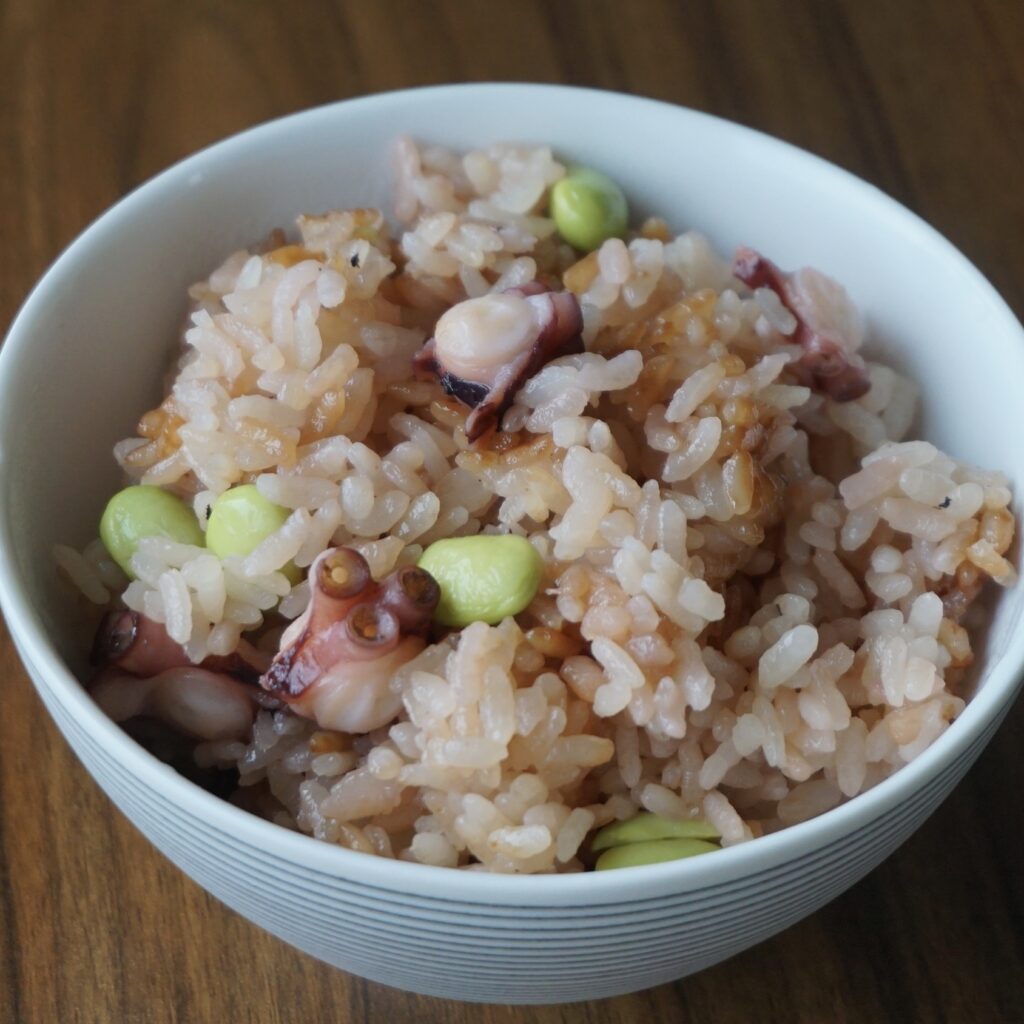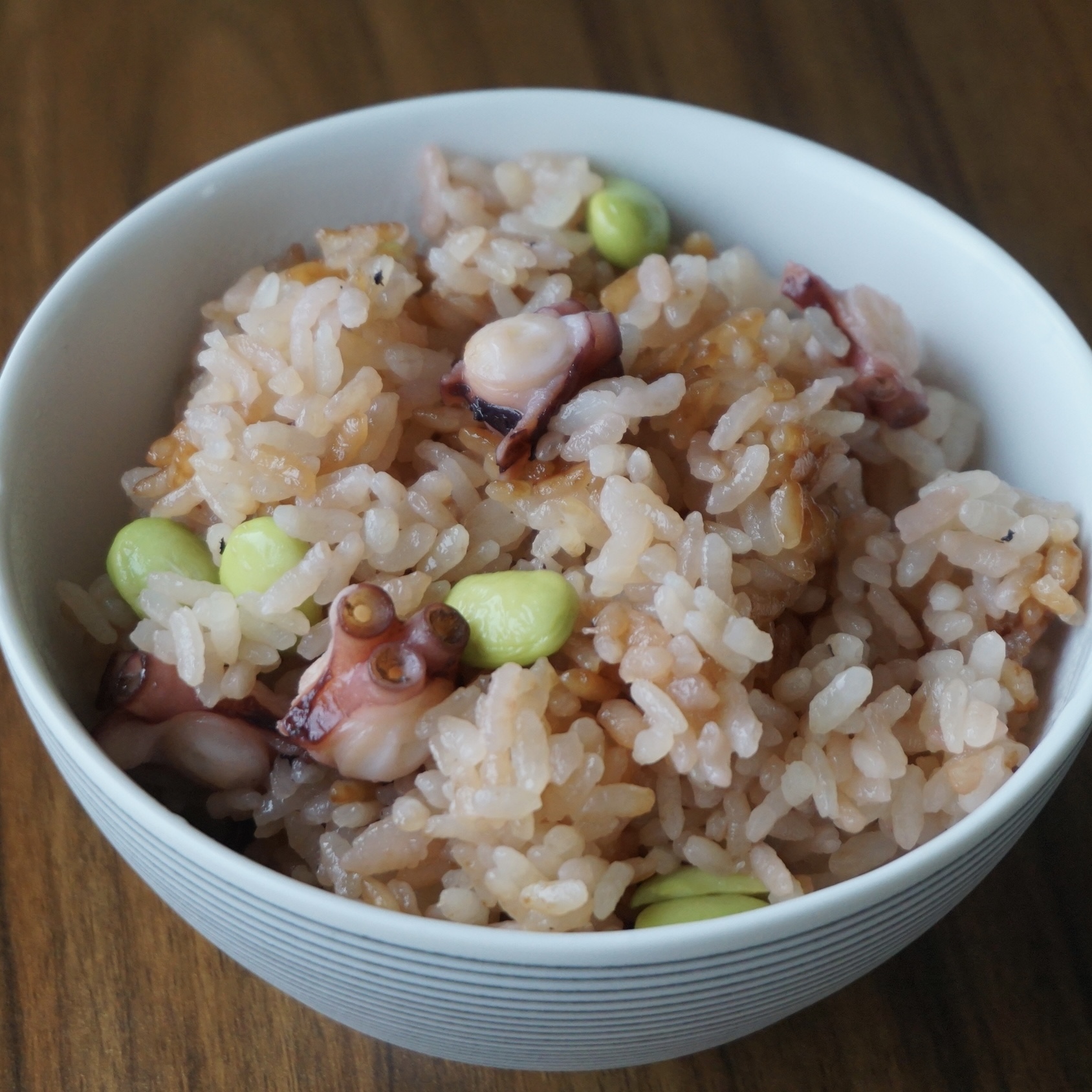
Tako meshi (octopus rice)
What kind of food is Tako meshi (octopus rice)?
This is a recipe for takikomi gohan, made with fresh octopus and edamame beans. The seasoning is simple, using shiro dashi.
Shiro dashi is a versatile seasoning made by adding white soy sauce, light soy sauce, sugar, mirin, etc. to dashi made from bonito flakes, kelp, etc.
Tako meshi (Octopus rice) spread throughout Japan as a fisherman’s meal in coastal areas where octopus is caught, such as the Seto Inland Sea region and the Tokai region centered around Aichi Prefecture.
Octopus loses its flavor easily and is often distributed after being cooked, so the most popular method is to purchase boiled octopus, simmer it in soy sauce, and then mix it with rice.
However, in Aichi Prefecture, where fresh octopus is readily available, raw octopus is often cooked together with rice.
Cooking raw octopus with rice gives the rice a beautiful cherry blossom pink, so the dish is sometimes called “sakurameshi (blossom rice).”
Eight is considered an auspicious number, and because octopuses have eight legs and suckers, it is said that in ancient Japan, where rice cultivation was thriving, octopus was offered to the gods in the hope that rice seedlings would take root firmly.
A common variation is to add flavor by topping it with ginger, green onions, kinome (sansho pepper sprouts), or green laver.
I used edamame beans to add color and texture.
What kind of food is Octopus?
This mollusk has a chewy texture. The pouch-like part on top is not a head, but a hollow cavity; the actual head is located behind the eyes.
Madako is considered the tastiest of all octopuses. It is rarely sold raw; most are boiled and then sold.
Even raw octopus is sold salted (rubbed with salt and then washed) to remove the slime.
Its flavor is easily compromised, so it should be eaten soon after purchase.
(Iidako is a small octopus, about 10 cm long. It is typically boiled in soy sauce and sugar.)
Octopus, squid, and shellfish contain high amounts of taurine.
This amino acid is also found in large amounts in human organs such as muscle, bone marrow, brain, and lungs.
Taurine intake is believed to help maintain normal blood pressure, regulate blood cholesterol, and promote fat burning.
Taurine’s detoxifying effect in the liver has particularly attracted attention, and it has been reported to suppress the formation of gallstones.
By the way, squid ink contains a lot of umami components and is slightly viscous. Octopus ink is runny and has little umami flavor, so it is rarely eaten.
NUTRITION FACTS : Tako meshi (octopus rice)

1367 Calories Protein 53.2 g Total Fat 11.7 g Total Carbohydrates 266.4g sodium 8.8g
INGREDIENTS : Tako meshi (octopus rice) (5SERVINGS)
- Octopus (100g/I purchased salted octopus. purchased salted octopus.)
- Rice (2 cups, 320g)
- Water (360g)
- White dashi (50g)
- Edamame (130gThe amount of beans removed from the bunch is 70ghe amount of beans removed from the bunch is 70g)
- Salt (20g)
- Water (100g)
- Salt (20g)
How to make Tako meshi (octopus rice)
- Wash the rice.
- Put rice, shiro dashi, and water in the rice cooker pot and mix.
- Place the octopus, cut into 1cm cubes, on top of the rice.
- Cook the rice on the quick cook setting.
- Wash the edamame beans carefully and drain.
- Sprinkle 20g of salt over the edamame beans and rub them with both hands to rub the salt in.
- Rinse the edamame beans under running water and cut off the ends of the bunches (you can do this from both ends or just one end).
- Bring the water to a boil, add the remaining 20g of salt, and boil the edamame for 6-8 minutes.
- Mix the cooked rice and edamame beans.



コメント